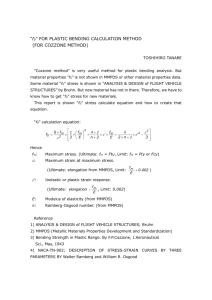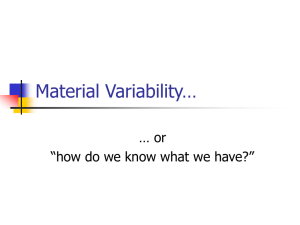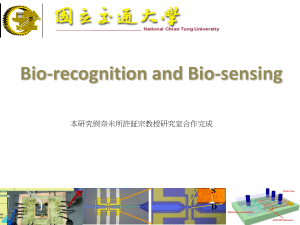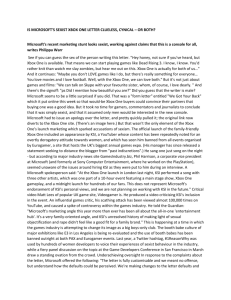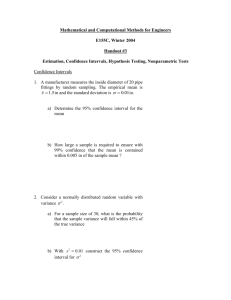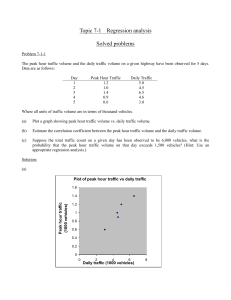Instruction Manual Vibration Velocity Sensor / Transmitter KSI 80VC
advertisement
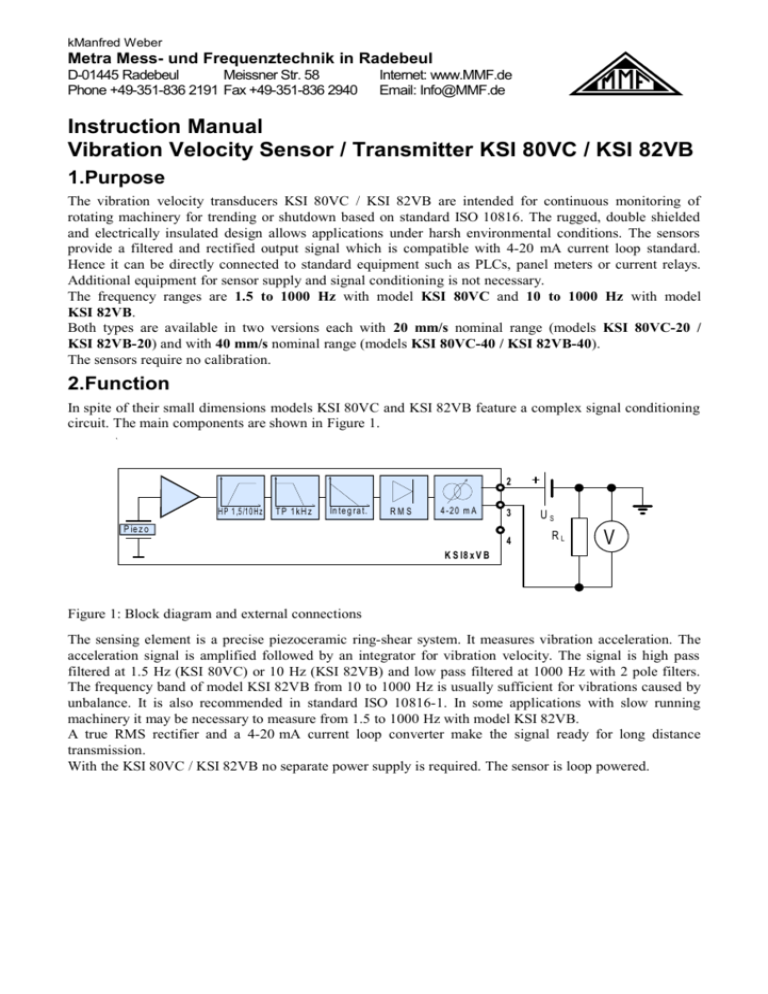
kManfred Weber Metra Mess- und Frequenztechnik in Radebeul D-01445 Radebeul Meissner Str. 58 Phone +49-351-836 2191 Fax +49-351-836 2940 Internet: www.MMF.de Email: Info@MMF.de Instruction Manual Vibration Velocity Sensor / Transmitter KSI 80VC / KSI 82VB 1.Purpose The vibration velocity transducers KSI 80VC / KSI 82VB are intended for continuous monitoring of rotating machinery for trending or shutdown based on standard ISO 10816. The rugged, double shielded and electrically insulated design allows applications under harsh environmental conditions. The sensors provide a filtered and rectified output signal which is compatible with 4-20 mA current loop standard. Hence it can be directly connected to standard equipment such as PLCs, panel meters or current relays. Additional equipment for sensor supply and signal conditioning is not necessary. The frequency ranges are 1.5 to 1000 Hz with model KSI 80VC and 10 to 1000 Hz with model KSI 82VB. Both types are available in two versions each with 20 mm/s nominal range (models KSI 80VC-20 / KSI 82VB-20) and with 40 mm/s nominal range (models KSI 80VC-40 / KSI 82VB-40). The sensors require no calibration. 2.Function In spite of their small dimensions models KSI 80VC and KSI 82VB feature a complex signal conditioning circuit. The main components are shown in Figure 1. ` 2 H P 1 ,5/10H z T P 1 kH z In te g ra t. RMS 4 -20 m A 3 P ie z o 4 US RL V K S I8 x V B Figure 1: Block diagram and external connections The sensing element is a precise piezoceramic ring-shear system. It measures vibration acceleration. The acceleration signal is amplified followed by an integrator for vibration velocity. The signal is high pass filtered at 1.5 Hz (KSI 80VC) or 10 Hz (KSI 82VB) and low pass filtered at 1000 Hz with 2 pole filters. The frequency band of model KSI 82VB from 10 to 1000 Hz is usually sufficient for vibrations caused by unbalance. It is also recommended in standard ISO 10816-1. In some applications with slow running machinery it may be necessary to measure from 1.5 to 1000 Hz with model KSI 82VB. A true RMS rectifier and a 4-20 mA current loop converter make the signal ready for long distance transmission. With the KSI 80VC / KSI 82VB no separate power supply is required. The sensor is loop powered. 3.Mounting and Connection Mounting KSI 80V KSI 82V An important condition for accurate vibration measurement is the selection of suitable measuring points on the structure. For this purpose it can be helpful to consult a specialist with experience in machine monitoring. In general, it is advisable to measure vibration as near as possible to its source. This will minimize distortion of the measured signal by transmitting mechanical components. Suitable measuring points are rigid components, for instance the housing of bearings or gearboxes. Not recommended for vibration measurement are lightweight, flexible and soft components. The standard ISO 10816-1 gives some recommendations for suitable measuring points. The KSI 80VC / KSI 82VB can be mounted using an M8 stud bolt which is screwed into the tapped hole of the sensor base. The sensor can also be mounted by a magnetic base Model 208 (M8) or Model 008 (M5) with the adapter Model 044. A perfect vibration transmission from the measuring object to the sensor is crucial for precise results. Rough, scratched or too small measuring points may cause errors. Cast or varnish surfaces are unsuited. It is recommended to prepare the measuring point by epoxy cementing a polished steel plate M8 Model 229 with M8 stud. A thin layer of silicon grease will also improve vibration transmission. Epoxy Connection Please read the following carefully. Connection failures may cause malfunction or even damage to the sensor. ! Models KSI 80VC / KSI 82VB are connected via a waterproof four pin M12 connector model Binder 713. The following optional connection accessories are available from Metra: Model 080G/W: Straight (G) or angled (W) plug of Binder 713 series with screw terminals for simple connection to existing cables, protection grade IP67 Model 084G/W: 5 m shielded cable with 4 wires, with straight (G) or angled (W) plug Binder 713 and pigtail ends; protection grade IP67 The pin assignment is as follows: View at socket ! 4 3 1 2 Pin Assignment 1: 2: 3: 4: No connection + current loop - current loop case If the test object has no connection to earth potential, connect pin 4 to earth or another reference potential to ensure proper shielding. Make sure that the cable is not routed alongside AC power lines. It must cross AC power lines at right angles. The cable should also be routed away from potential sources of EMI, e.g. motors, frequency converters, generators, transformers or radio transmitters. The sensor cable should be anchored to reduce stress at the connector. When securing the cable, leave enough slack to allow free movement of the sensor. The sensor output is connected via pin 2 and 3. Any two conductor cable can be used. At long distances and high EMI, however, it is recommended to use shielded two conductor cables. The cable shield should be tied to earth potential only at one side to avoid ground loops. The 4-20 mA loop is powered from a filtered DC voltage source U S as shown in Figure 1. The load resistor RL is in series with the sensor. The load resistor R L and the voltage source US are often part of the read-out or processing equipment. The KSI 80VC / KSI 82VB requires for normal operation a minimum voltage drop of 12 VDC across its terminals. Figure 2 shows the permissible limits for the load resistor R L against the loop supply voltage US. 500 Rmax(25mA) 400 300 Rmin(85°C) 200 100 0 Rmin(25°C) 12 15 18 21 24 27 Us / V 30 Figure 2: Permissible range for the load resistor against loop supply voltage ! Please make sure that the loop supply voltage U S is free of ripple. To suppress interference, it is recommended to connect the negative terminal of the voltage source to earth potential. A commercially available DC/DC converter (24 V : 24 V) may be used to regenerate a noisy 24 V supply. The 4-20 mA output is protected against reverse wiring. 4.What to Do if the Sensor Does Not Work Problem: The output is above 4 mA although the sensor is not exposed to vibration or the output is wrong. Check the quality of your loop supply. If there is AC ripple, use a separate 24 VDC supply or regenerate the supply voltage by a DC/DC converter. In case of strong AC components at machine ground, particularly in the presence of frequency converters, interference within the sensor circuit may occur. This problem can be solved by isolated mounting using the isolating flange Model 206. Check the voltage drop at the loop terminals of the sensor. If it is less than 12 VDC, the sensor circuit may oscillate or the output may be clipped. If applicable, increase the loop supply voltage or lower the load resistance. If the problem should persist in spite of these measures, please contact the manufacturer. 5.Optionally Available Accessories 080G/W: 084G/W: 043: 229: 208: M12DIS: Plug Binder 713 straight (G) or angled (W) with screw terminals 5 m cable with plug Binder 713 straight (G) or angled (W) and pigtail ends Stud bolt M8 x 16 Adhesive mounting pad M8 Magnetic base with M8 stud LCD module for vibration velocity display, 4-20 mA input, with backlight 6.Technical Data Output: Measuring range (vMIN .. vMAX): Nominal value at 20 mA: Sensitivity: Frequency range (-3 dB): Frequency range (-10 %): Non-linearity (vMIN .. vMAX, 25 °C): Residual noise: Output ripple: f > 5 Hz f = 3 Hz f = 1,5 Hz Settling time to 1 % tolerance: Destruction shock limit: Transverse sensitivity: Loop supply voltage: Maximum linear output current: Maximum output current at overload: Operating temperature range: Temperature coefficient of sensitivity: Temperature drift of zero point: Protection grade: Case material: Weight without cable: Mounting: KSI 80VC-20 KSI 80VC-40 KSI 82VB-20 KSI 82VB-40 RMS of vibration velocity, 4-20 mA 0.2 .. 25 mm/s 0.4 .. 50 mm/s 0.2 .. 25 mm/s 0.4 .. 50 mm/s 20 mm/s 40 mm/s 20 mm/s 40 mm/s 0,8 mA/mms -1 0,4 mA/mms-1 0,8 mA/mms-1 0,4 mA/mms-1 1.5 .. 1000 Hz 10 .. 1000 Hz 3 .. 650 Hz 20 .. 650 Hz ±3% ± 0.01 mm/s ± 0.005 mm/s <1% 2% 6% 10 s 2s ± 4000 g <5% 12 .. 30 V 25 mA < 35 mA - 40 .. 85 °C ± 0.05 %/K + 0.9 µms-1/K IP67 Stainless steel 66 g M8 tapped hole in base Limited Warranty Metra warrants for a period of 24 months that its products will be free from defects in material or workmanship and shall conform to the specifications current at the time of shipment. The warranty period starts with the date of invoice. The customer must provide the dated bill of sale as evidence. The warranty period ends after 24 months. Repairs do not extend the warranty period. This limited warranty covers only defects which arise as a result of normal use according to the instruction manual. Metra’s responsibility under this warranty does not apply to any improper or inadequate maintenance or modification and operation outside the product’s specifications. Shipment to Metra will be paid by the customer. The repaired or replaced product will be sent back at Metra’s expense. #131 Mar/15 Declaration of Conformity Product: Vibration Velocity Sensor / Transmitter Models: KSI 80VC / KSI 82VB It is hereby certified that the above mentioned products comply with the demands pursuant to the following standards: EN 50081-1 EN 50082-1 Responsible for this declaration is the producer Metra Mess- und Frequenztechnik Meissner Str. 58 D-01445 Radebeul Declared by Michael Weber Radebeul, June 1, 2006
